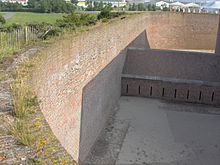- Counterscarp
-
 Counterscarp of a Napoleon era polygonal fort (Fort Napoleon, Ostend). Counterscarps had become vertical by this time. The housing at the bottom of the ditch is a caponier from where the defenders could fire on attackers that managed to climb down into the ditch, while being protected from cannon fire themselves.
Counterscarp of a Napoleon era polygonal fort (Fort Napoleon, Ostend). Counterscarps had become vertical by this time. The housing at the bottom of the ditch is a caponier from where the defenders could fire on attackers that managed to climb down into the ditch, while being protected from cannon fire themselves.
A scarp and a counterscarp are the inner and outer sides of a ditch used in fortifications. In permanent fortifications the scarp and counterscarp may be encased in stone. In less permanent fortifications, the counterscarp may be lined with paling fence set at an angle so as to give no cover to the attackers but to make advancing and retreating more difficult.
If an attacker succeeds in breaching a wall a coupure can be built on the inside of the wall to hinder the forlorn hope in which case the counterscarp is also the side of the ditch farthest from the breached wall and closest to the centre of the fortification.[1][2]
References
 This article incorporates text from a publication now in the public domain: Chisholm, Hugh, ed (1911). Encyclopædia Britannica (11th ed.). Cambridge University Press. from the article COUNTERSCARP
This article incorporates text from a publication now in the public domain: Chisholm, Hugh, ed (1911). Encyclopædia Britannica (11th ed.). Cambridge University Press. from the article COUNTERSCARP- counterscarp: European fortress wall - Art - Britannica Concise: diagram
- Stephen Francis Wyley (Drawings by Steven Lowe) A Dictionary of Military Architecture Fortification and Fieldworks from the Iron Age to the Eighteenth Century: Counterscarp
- Counterscarp Gallery
- E. Cobham Brewer 1810–1897 Dictionary of Phrase and Fable. 1898: Counterscarp
Further reading
Footnotes
- ^ Clonmel: Its Monastery, and Siege by Cromwell From Duffy's Hibernian Magazine, Vol. III, No. 14, August 1861
- ^ The term "scarp" is from the same origin as a "scarp slope", the leading edge of escarpment, and in this case the escarpment is the ditch and wall of a fortress. So if a defensive ditch is dug on the inner side of a wall then there can be a counterscarp on both side of the wall.
Categories:- Sieges
- Fortification
Wikimedia Foundation. 2010.
